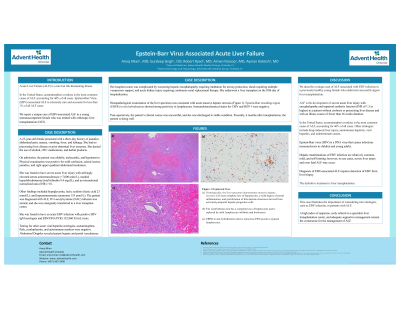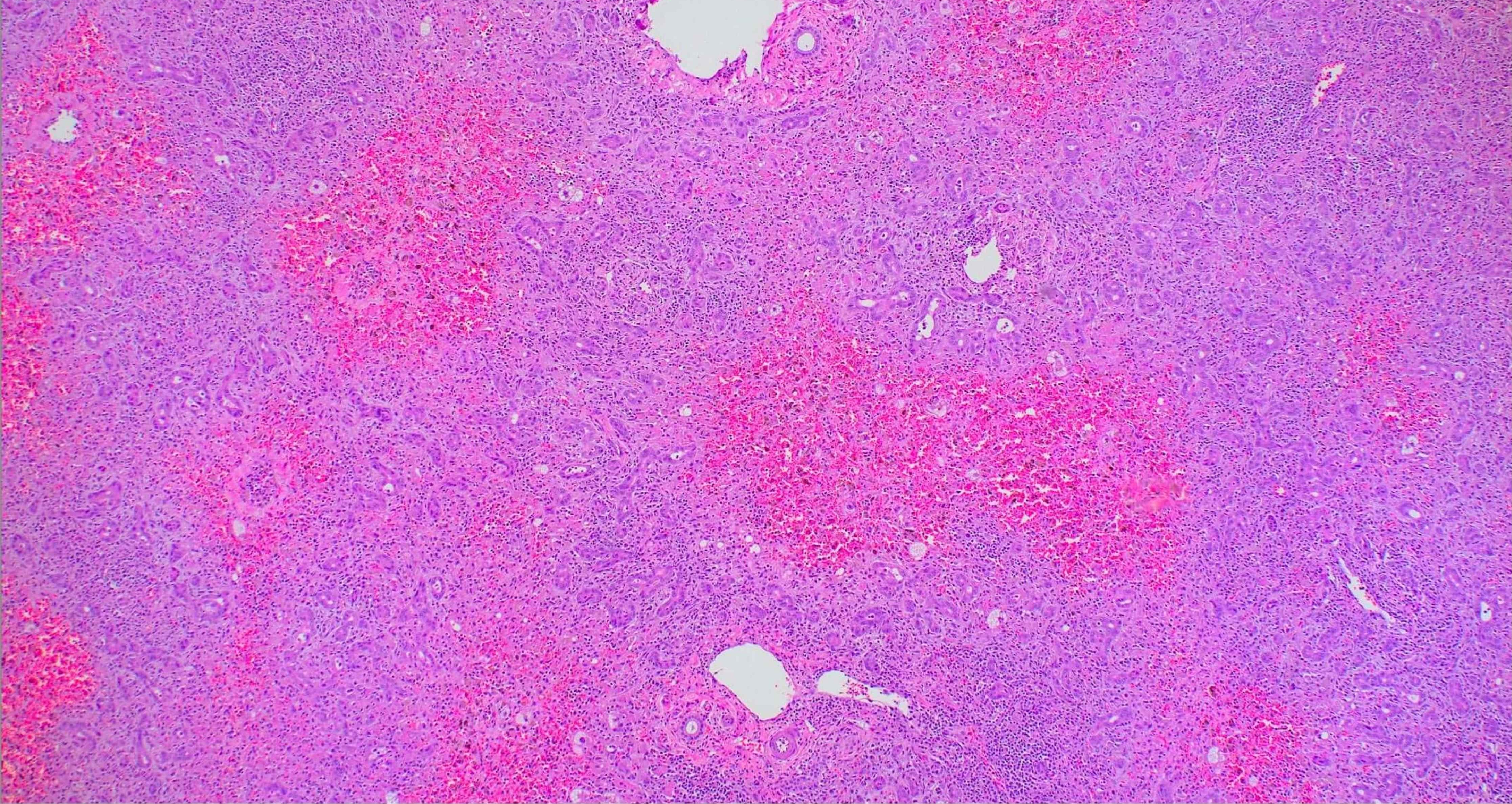Tuesday Poster Session
Category: Liver
P3935 - Epstein-Barr Virus Associated Acute Liver Failure
Tuesday, October 24, 2023
10:30 AM - 4:00 PM PT
Location: Exhibit Hall

Has Audio

Arooj Mian, MD
AdventHealth
Orlando, FL
Presenting Author(s)
Arooj Mian, MD, Gurdeep Singh, DO, Robert Ryad, MD, Aimen Farooq, MD, Ayman Koteish, MD
AdventHealth, Orlando, FL
Introduction: Acute Liver Failure (ALF) is defined as severe acute liver injury, impaired synthetic function, and hepatic encephalopathy. The most common cause of ALF in the United States is acetaminophen overdose. We present a unique case of Epstein-Barr Virus associated ALF.
Case Description/Methods: A 23-year-old female with presented with a 3-day history of jaundice, abdominal pain, nausea, vomiting, fever, and lethargy. She had no preexisting liver disease or prior abnormal liver enzymes. She denied the use of alcohol, illicit drugs, and toxins.
Physical examination was positive for mild confusion, scleral icterus, jaundice, and right upper quadrant abdominal tenderness. She was found to have severe acute liver injury with strikingly elevated serum aminotransferases ( >7,000 units/L), marked hyperbilirubinemia (total bilirubin 9.4 mg/dL), and international normalized ratio >18. Other findings included hypoglycemia, lactic acidosis (lactic acid 23 mmol/L), and hyperammonemia (ammonia 153 umol/L). Patient was diagnosed with acute liver failure, intravenous n-acetylcysteine (NAC) infusion was started, and she was emergently transferred to a liver transplant center. Her hospital course was complicated by worsening hepatic encephalopathy requiring intubation for airway protection, shock requiring multiple vasopressor support, and acute kidney injury requiring continuous renal replacement therapy.
She was found to have an acute Epstein-Barr Virus (EBV) infection with positive EBV IgM serologies and polymerase chain reaction (EBV PCR 152,860 IU/mL) tests. Testing for other acute viral hepatitis serologies, ceruloplasmin, acetaminophen, and ethanol was negative. Abdominal doppler ultrasound revealed patent hepatic and portal vasculatures. She underwent a liver transplant on the fifth day of hospitalization. Histopathological examination of the liver specimen was consistent with acute massive hepatic necrosis due to EBV. The centrilobular area had complete loss of hepatocytes and was replaced by a mild lymphocytic infiltrate and histiocytes. EBER ish showed strong positivity in lymphocytes.Post-operatively, the patient’s clinical course was uneventful, and he was discharged in stable condition.
Discussion: EBV is a rare cause of ALF. Our case report aims to create awareness amongst clinicians of this rare but life-threatening complication of acute EBV infection.

Disclosures:
Arooj Mian, MD, Gurdeep Singh, DO, Robert Ryad, MD, Aimen Farooq, MD, Ayman Koteish, MD. P3935 - Epstein-Barr Virus Associated Acute Liver Failure, ACG 2023 Annual Scientific Meeting Abstracts. Vancouver, BC, Canada: American College of Gastroenterology.
AdventHealth, Orlando, FL
Introduction: Acute Liver Failure (ALF) is defined as severe acute liver injury, impaired synthetic function, and hepatic encephalopathy. The most common cause of ALF in the United States is acetaminophen overdose. We present a unique case of Epstein-Barr Virus associated ALF.
Case Description/Methods: A 23-year-old female with presented with a 3-day history of jaundice, abdominal pain, nausea, vomiting, fever, and lethargy. She had no preexisting liver disease or prior abnormal liver enzymes. She denied the use of alcohol, illicit drugs, and toxins.
Physical examination was positive for mild confusion, scleral icterus, jaundice, and right upper quadrant abdominal tenderness. She was found to have severe acute liver injury with strikingly elevated serum aminotransferases ( >7,000 units/L), marked hyperbilirubinemia (total bilirubin 9.4 mg/dL), and international normalized ratio >18. Other findings included hypoglycemia, lactic acidosis (lactic acid 23 mmol/L), and hyperammonemia (ammonia 153 umol/L). Patient was diagnosed with acute liver failure, intravenous n-acetylcysteine (NAC) infusion was started, and she was emergently transferred to a liver transplant center. Her hospital course was complicated by worsening hepatic encephalopathy requiring intubation for airway protection, shock requiring multiple vasopressor support, and acute kidney injury requiring continuous renal replacement therapy.
She was found to have an acute Epstein-Barr Virus (EBV) infection with positive EBV IgM serologies and polymerase chain reaction (EBV PCR 152,860 IU/mL) tests. Testing for other acute viral hepatitis serologies, ceruloplasmin, acetaminophen, and ethanol was negative. Abdominal doppler ultrasound revealed patent hepatic and portal vasculatures. She underwent a liver transplant on the fifth day of hospitalization. Histopathological examination of the liver specimen was consistent with acute massive hepatic necrosis due to EBV. The centrilobular area had complete loss of hepatocytes and was replaced by a mild lymphocytic infiltrate and histiocytes. EBER ish showed strong positivity in lymphocytes.Post-operatively, the patient’s clinical course was uneventful, and he was discharged in stable condition.
Discussion: EBV is a rare cause of ALF. Our case report aims to create awareness amongst clinicians of this rare but life-threatening complication of acute EBV infection.

Figure: The liver specimen demonstrates near complete loss of hepatocytes, mild degree of portal inflammation and proliferation of bile ductule structures derived from activated periportal hepatic progenitor cells. The centrilobular area has complete loss of hepatocytes and is replaced by mild lymphocytic infiltrate and histiocytes. There is no significant inflammation in zone 3. Iron stain and copper stain are negative. Reticulin stain shows no additional findings. EBER ish shows strong positive in lymphocytes. The histologic findings of this case is acute massive hepatic necrosis, possible due to EBV.
Disclosures:
Arooj Mian indicated no relevant financial relationships.
Gurdeep Singh indicated no relevant financial relationships.
Robert Ryad indicated no relevant financial relationships.
Aimen Farooq indicated no relevant financial relationships.
Ayman Koteish indicated no relevant financial relationships.
Arooj Mian, MD, Gurdeep Singh, DO, Robert Ryad, MD, Aimen Farooq, MD, Ayman Koteish, MD. P3935 - Epstein-Barr Virus Associated Acute Liver Failure, ACG 2023 Annual Scientific Meeting Abstracts. Vancouver, BC, Canada: American College of Gastroenterology.
